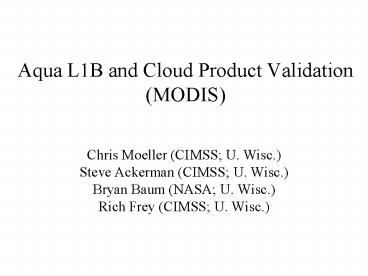Aqua L1B and Cloud Product Validation (MODIS) PowerPoint PPT Presentation
1 / 36
Title: Aqua L1B and Cloud Product Validation (MODIS)
1
Aqua L1B and Cloud Product Validation (MODIS)
- Chris Moeller (CIMSS U. Wisc.)
- Steve Ackerman (CIMSS U. Wisc.)
- Bryan Baum (NASA U. Wisc.)
- Rich Frey (CIMSS U. Wisc.)
2
THORPex ER-2 DeploymentEOS-related objectives
- Aqua AIRS/MODIS L1B assessment (clear sky)
- multi-angle (lt 30 off-nadir)
- Clear sky, water background
- Aqua/Terra MODIS Cloud product assessment
- Cloud heights/emissivity (tropical cirrus)
- Cloud particle phase (multi-layer, supercooled
liquid water) - Cloud Mask validation (thin cirrus detection,
heavy aerosol) - S-HIS/NAST-I calibration comparisons
- Warm and cold scenes
- MODIS water color
- MOBY buoy site off island of Lanai
3
MODIS TIR Band L1B
- Objective
- Assess radiometric accuracy using clear sky
- ocean background scenes.
- Sample nadir and off-nadir viewing angles.
4
(No Transcript)
5
MODIS 11um April 01, 2001 1635 UTC
6
(No Transcript)
7
MAS 11um imagery for April 01, 2001
MODIS Footprint
8
(No Transcript)
9
ER-2 Level
MODIS B30, 9.6um (Ozone) MODIS B33, 13.3um
(CO2) MODIS B35, 13.9um (CO2) MODIS B36, 14.2um
(CO2) MAS B43, 9.6um (Ozone) MAS B48, 13.2um
(CO2) MAS B49, 13.8um (CO2) MAS B50, 14.3um (CO2)
10
Influence of Altitude Difference between MODIS
and MAS
CO2
Ozone
Atmospheric absorption above the ER-2 altitude
(20 km) is important for O3 and CO2 sensitive
bands.
11
Brightness Temperature (K)
Time (HH.HH)
12
MODIS Residual (K)
MODIS Band Number
13
(No Transcript)
14
(No Transcript)
15
S-HIS and NAST-I Radiometric Comparisons
- S-HIS and NAST-I
- CLAMS 17 July 2001
- Golden Day
- S-HIS on ER-2
- NAST-I on Proteus
Chesapeake Lighthouse
295
290
285
- Stacked aircraft comparison.
- Thin cirrus observed below ER-2 but above
Proteus accounts for difference in observed
brightness temperatures.
B.T.
280
NAST-I (red) S-HIS (blue)
275
270
12 ?m
10.8 ?m
16
MODIS Cloud Particle Phase
- Objective
- Assess MODIS TIR band cloud phase product
- for single layer clouds.
- Learn more about difficult mixed phase and
- multi-layer scenes.
- Supercooled water cases of particular interest.
17
MODIS Cloud Particle Phase
MODIS Band 31 (11um)
18
(No Transcript)
19
(No Transcript)
20
(No Transcript)
21
ER-2/CPL CRYSTAL 29 Jul 02 (Flt
02-956) Attenuated Backscatter Coefficient and
Depolarization
Height (km)
22
ER-2/CPL CRYSTAL 29 Jul 02 (Flt
02-956) Attenuated Backscatter Coefficient and
Depolarization
Height (km)
23
MODIS Cloud Height
- Objective
- Assess MODIS CO2 cloud heights for mid
- and upper level single and multi-layer clouds.
- Characterize cloud optical properties.
24
MODIS vs. MISR vs GOES SGP22-Aug-2001, 1725,
P027, O8932
(Muller, Naud, Clothiaux, de Valk)
25
(No Transcript)
26
(No Transcript)
27
Aqua MODIS B34
Terra MODIS B34
28
MODIS Cloud Mask
- Objective
- Assess performance of thin cirrus detection
- Characterize thin cirrus thats being detected
29
B2 (.86um)
B26 (1.38um)
MODIS over tropical Pacific
30
B31 (11um)
B26 (1.38um)
MODIS over tropical Pacific
31
Thin Cirrus
Cloud Mask
MODIS over tropical Pacific
32
Lowering the Cirrus Cloud detection threshold
will capture much thinner cirrus (optical depth
of 0.08 in this example)
B26 Cloud test threshold in V3.0.0 (current)
1.38um Cloud Model Reflectance
New B26 Cloud test threshold under evaluation
Optical depth detectable with new threshold
Cloud Optical Depth
33
MODIS Ocean Colorw/Dennis Clark (MST)
MOBY
34
35
ASAP Science Plan Goals at Univ. of Wisconsin for
THORpex 2003
- Hyperspectral data collection in support of new
research - turbulence (Jet Steam, CAT CIT)
- convection for diagnostics/nowcasting/identificat
ion - cloud properties (levels microphysics)
- dust aerosol identification and transport
- Test new ASAP algorithms with hyperspectral
GIFTS data. - Sensor validation (GOES, MODIS).
- Use THORpex data sets for Years 1-3 of ASAP by
- NCARCIMSS ASAP teams.
- GIFTS cube generation for GIFTS fast, forward
and - retrieval algorithm testing/development over
oceans. - Coordinate with THORpex scientists for data
collection.
John R. Mecikalski UW/CIMSS
36
Schematic of Observation Collectionsfor Aviation
Hazards Surrounding the Jet Stream
o - Weak-Inertial Stability/High-Shear induced
Turbulence
Jet Entrance Region (turbulence)
Trough Axis (icing)
Jet Stream
?
Hawaii
Midway
x - Low Stability/Strong QG Vertical Motions
Turbulence/Convection
John R. Mecikalski UW/CIMSS

